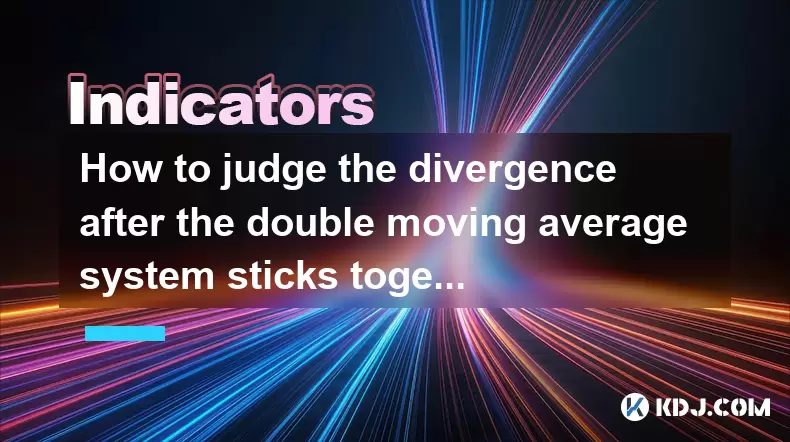-
 bitcoin
bitcoin $113137.862908 USD
0.65% -
 ethereum
ethereum $4107.436072 USD
-1.96% -
 xrp
xrp $2.908808 USD
2.59% -
 tether
tether $1.000294 USD
0.01% -
 bnb
bnb $1010.914842 USD
-1.12% -
 solana
solana $210.653310 USD
-2.16% -
 usd-coin
usd-coin $0.999776 USD
-0.01% -
 dogecoin
dogecoin $0.239360 USD
-0.04% -
 tron
tron $0.337849 USD
0.37% -
 cardano
cardano $0.807698 USD
-0.61% -
 hyperliquid
hyperliquid $45.387447 USD
0.61% -
 chainlink
chainlink $21.408287 USD
-0.92% -
 ethena-usde
ethena-usde $1.000509 USD
-0.04% -
 avalanche
avalanche $32.634682 USD
-4.77% -
 sui
sui $3.349772 USD
-0.19%
How to judge the divergence after the double moving average system sticks together? Which form indicates the start of trend?
The double moving average system uses short-term and long-term averages to signal trend changes; divergence after convergence indicates potential new trends in crypto markets.
Jun 15, 2025 at 02:15 pm

Introduction to Double Moving Average System
The double moving average system is a popular technical analysis tool used by traders to identify potential trend changes and entry or exit points in the cryptocurrency market. This system involves plotting two moving averages on a price chart: a short-term moving average and a long-term moving average. When these two moving averages converge or 'stick together', it often signals a period of consolidation or a potential change in the trend. Understanding the divergence after this convergence is crucial for making informed trading decisions.
Understanding Convergence and Divergence
Convergence in the context of the double moving average system refers to the point where the short-term and long-term moving averages come close to each other or cross. This phenomenon often indicates that the market is in a state of equilibrium, with no clear directional bias. Divergence, on the other hand, occurs when these moving averages start to separate from each other after a period of convergence. This separation can signal the beginning of a new trend.
Identifying Divergence After Convergence
To judge the divergence after the moving averages stick together, traders need to observe the following steps:
- Monitor the Moving Averages: After the moving averages converge, keep a close eye on them. A clear separation between the short-term and long-term moving averages indicates the start of divergence.
- Check the Direction of Divergence: If the short-term moving average starts to move above the long-term moving average, it may signal the beginning of an uptrend. Conversely, if the short-term moving average moves below the long-term moving average, it could indicate the start of a downtrend.
- Confirm with Volume and Other Indicators: To increase the reliability of the signal, traders should look for confirmation from other indicators such as volume. An increase in trading volume during the divergence can reinforce the signal of a new trend.
Forms of Divergence Indicating the Start of a Trend
The form of divergence that indicates the start of a trend can be categorized into two main types:
- Bullish Divergence: This occurs when the short-term moving average crosses above the long-term moving average after a period of convergence. This crossover is often considered a buy signal, indicating that the market is likely to enter an uptrend.
- Bearish Divergence: Conversely, bearish divergence happens when the short-term moving average crosses below the long-term moving average. This crossover is typically seen as a sell signal, suggesting that the market might be entering a downtrend.
Practical Example of Divergence After Convergence
Let's consider a practical example to illustrate how to judge divergence after the double moving average system sticks together. Suppose you are analyzing the price chart of Bitcoin (BTC) using a 50-day short-term moving average and a 200-day long-term moving average.
- Step 1: You notice that the 50-day and 200-day moving averages have converged and are moving closely together, indicating a period of consolidation.
- Step 2: After a few weeks, the 50-day moving average starts to move upwards, away from the 200-day moving average. This separation signals the beginning of divergence.
- Step 3: You observe that the 50-day moving average eventually crosses above the 200-day moving average. This crossover confirms a bullish divergence, suggesting the start of an uptrend.
- Step 4: To confirm the signal, you check the trading volume and find that it has increased during the divergence, further supporting the likelihood of an uptrend.
Using Divergence for Trading Decisions
Once you have identified the divergence after the moving averages stick together, you can use this information to make trading decisions. Here are some steps to follow:
- Enter a Trade: If you observe a bullish divergence, consider entering a long position (buying) to capitalize on the potential uptrend. Conversely, if you see a bearish divergence, you might want to enter a short position (selling) to profit from the expected downtrend.
- Set Stop-Loss and Take-Profit Levels: To manage risk, set a stop-loss order below the recent low for a long position or above the recent high for a short position. Additionally, set a take-profit level based on your analysis of potential resistance or support levels.
- Monitor the Trade: Continuously monitor the trade to ensure it aligns with your expectations. If the market moves against your position, be prepared to exit the trade to minimize losses.
Common Pitfalls and Considerations
While the double moving average system can be a powerful tool, there are some common pitfalls to be aware of:
- False Signals: Sometimes, the moving averages may diverge only to converge again without a significant trend change. It's essential to use additional indicators and analysis to confirm signals.
- Lag: Moving averages are lagging indicators, meaning they react to price changes rather than predict them. This lag can lead to delayed entry or exit points.
- Market Conditions: The effectiveness of the double moving average system can vary depending on market conditions. In highly volatile markets, the system may produce more false signals.
Frequently Asked Questions
Q: Can the double moving average system be used for all cryptocurrencies?A: Yes, the double moving average system can be applied to any cryptocurrency. However, the effectiveness may vary depending on the liquidity and volatility of the specific cryptocurrency. For less liquid cryptocurrencies, the system might produce more false signals.
Q: How do I choose the right time periods for the moving averages?A: The choice of time periods for the moving averages depends on your trading strategy and time horizon. Common combinations include the 50-day and 200-day moving averages for long-term trends, and the 10-day and 30-day moving averages for shorter-term trends. Experiment with different time periods to find what works best for your trading style.
Q: What other indicators can I use to confirm the divergence signals?A: In addition to volume, you can use other technical indicators such as the Relative Strength Index (RSI), Moving Average Convergence Divergence (MACD), and Bollinger Bands to confirm divergence signals. These indicators can provide additional insights into the strength and direction of the trend.
Q: How often should I check the moving averages for divergence?A: The frequency of checking the moving averages depends on your trading strategy. For day traders, checking the moving averages multiple times a day may be necessary. For swing traders or long-term investors, checking the moving averages daily or weekly might be sufficient. Adjust the frequency based on your trading goals and time commitment.
Disclaimer:info@kdj.com
The information provided is not trading advice. kdj.com does not assume any responsibility for any investments made based on the information provided in this article. Cryptocurrencies are highly volatile and it is highly recommended that you invest with caution after thorough research!
If you believe that the content used on this website infringes your copyright, please contact us immediately (info@kdj.com) and we will delete it promptly.
- NQA Token, AI Blockchain, and the Future of Rewire Finance: A New York Perspective
- 2025-09-25 22:45:12
- PayPal's PYUSD and DeFi Lending: A New Era?
- 2025-09-25 22:25:12
- Riding the Crypto Wave: Bitcoin, Cloud Mining, and the Future of Digital Assets
- 2025-09-25 22:45:12
- Solana, Price Prediction, Crypto ROI: Is SOL Still the Best Bet?
- 2025-09-25 22:50:01
- Ripple, RLUSD, and RWA Access: A New Era for XRP?
- 2025-09-25 22:50:02
- Griffin AI's $GAIN Token Plummets After Hack: Binance's Role in Recovery?
- 2025-09-25 22:50:02
Related knowledge

What is a tower bottom candlestick pattern? Does it have a high success rate?
Sep 22,2025 at 07:18am
Tower Bottom Candlestick Pattern Explained1. The tower bottom candlestick pattern is a reversal formation that typically appears at the end of a downt...

What is a black hole pattern in the MACD indicator? Is it a cause for concern?
Sep 21,2025 at 06:54pm
Bitcoin's Role in Decentralized Finance1. Bitcoin remains the cornerstone of decentralized finance, serving as a benchmark for value and security acro...

How can I use the psychological line (PSY) to determine market sentiment?
Sep 17,2025 at 02:19pm
Understanding the Psychological Line (PSY) in Cryptocurrency TradingThe Psychological Line, commonly referred to as PSY, is a momentum oscillator used...

How can I determine if a double top pattern has officially formed?
Sep 21,2025 at 03:18am
Understanding the Structure of a Double Top Pattern1. A double top pattern consists of two distinct peaks that reach approximately the same price leve...

What is the Golden Valley pattern on the moving average? Is it better than the Silver Valley pattern?
Sep 21,2025 at 02:54pm
Understanding the Golden Valley Pattern in Moving Averages1. The Golden Valley pattern is a technical formation observed in cryptocurrency price chart...

What does a death cross of the RSI in the strong zone (above 50) mean?
Sep 17,2025 at 10:54pm
Understanding the Death Cross in RSI Context1. The term 'death cross' is traditionally associated with moving averages, where a short-term average cro...

What is a tower bottom candlestick pattern? Does it have a high success rate?
Sep 22,2025 at 07:18am
Tower Bottom Candlestick Pattern Explained1. The tower bottom candlestick pattern is a reversal formation that typically appears at the end of a downt...

What is a black hole pattern in the MACD indicator? Is it a cause for concern?
Sep 21,2025 at 06:54pm
Bitcoin's Role in Decentralized Finance1. Bitcoin remains the cornerstone of decentralized finance, serving as a benchmark for value and security acro...

How can I use the psychological line (PSY) to determine market sentiment?
Sep 17,2025 at 02:19pm
Understanding the Psychological Line (PSY) in Cryptocurrency TradingThe Psychological Line, commonly referred to as PSY, is a momentum oscillator used...

How can I determine if a double top pattern has officially formed?
Sep 21,2025 at 03:18am
Understanding the Structure of a Double Top Pattern1. A double top pattern consists of two distinct peaks that reach approximately the same price leve...

What is the Golden Valley pattern on the moving average? Is it better than the Silver Valley pattern?
Sep 21,2025 at 02:54pm
Understanding the Golden Valley Pattern in Moving Averages1. The Golden Valley pattern is a technical formation observed in cryptocurrency price chart...

What does a death cross of the RSI in the strong zone (above 50) mean?
Sep 17,2025 at 10:54pm
Understanding the Death Cross in RSI Context1. The term 'death cross' is traditionally associated with moving averages, where a short-term average cro...
See all articles










































































